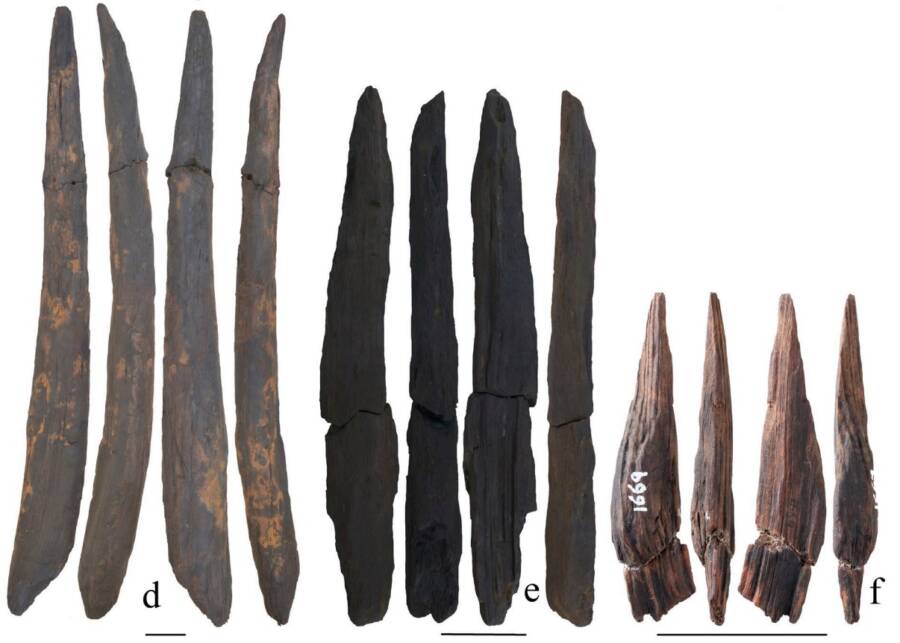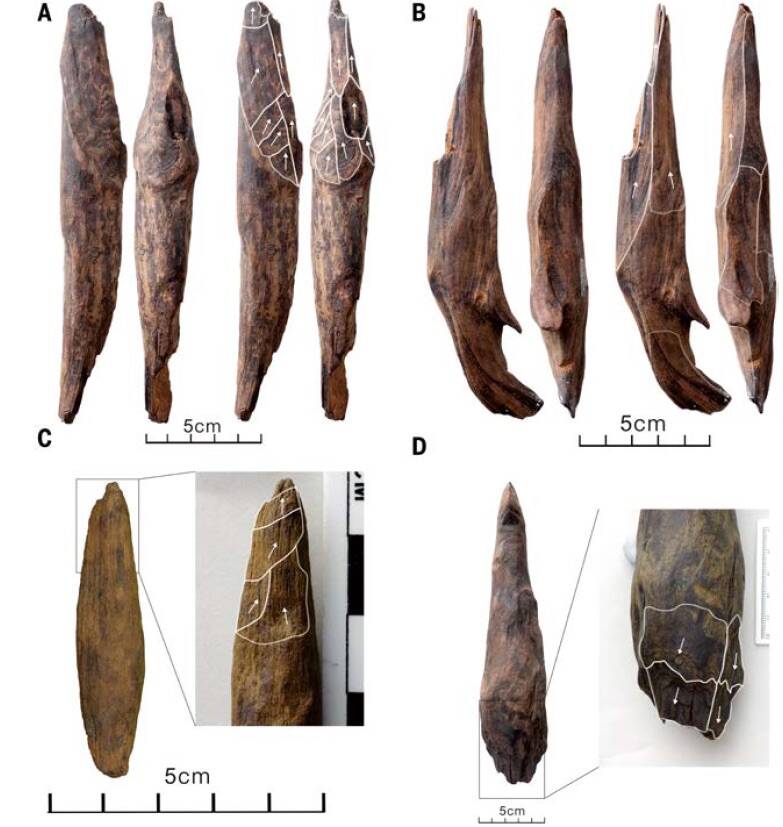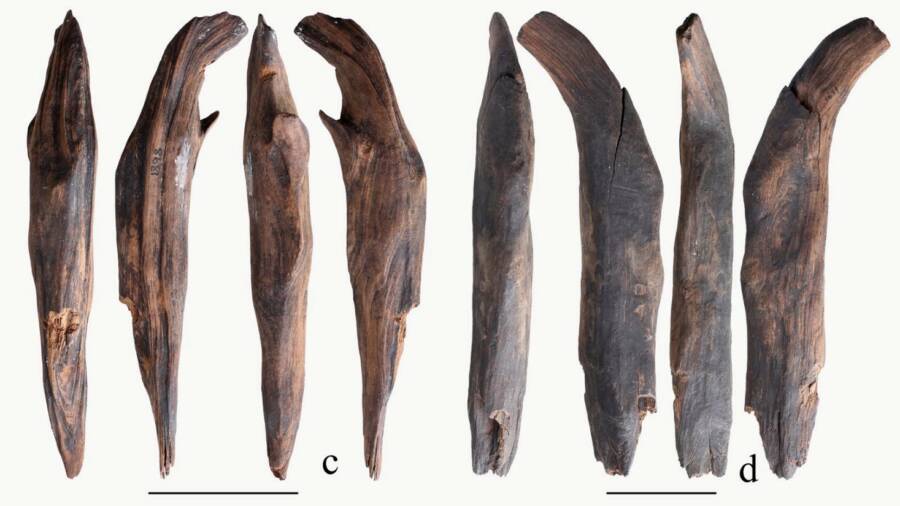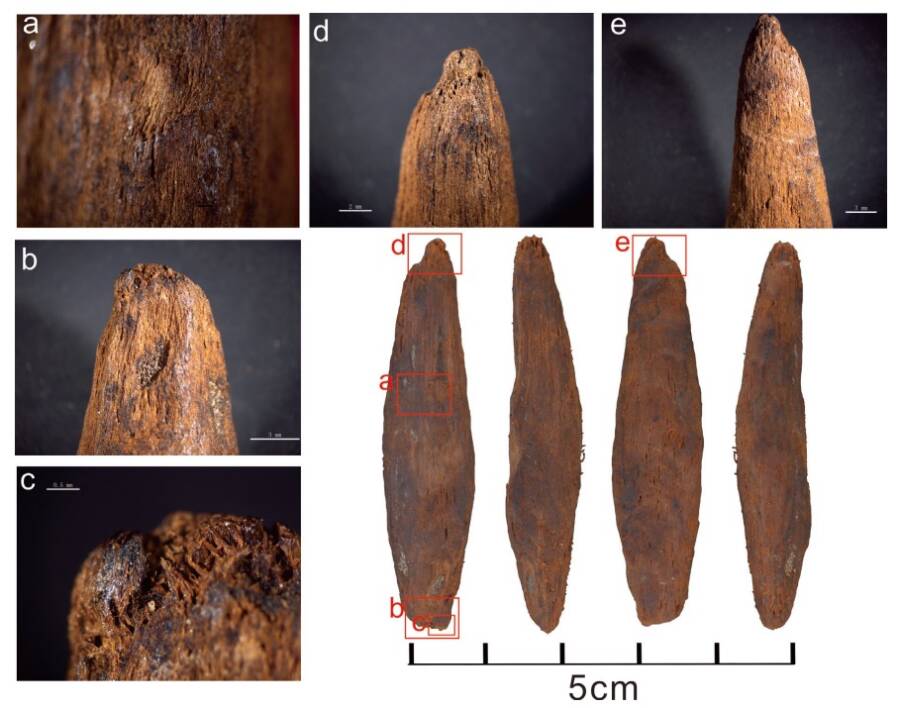The artifacts were preserved in low-oxygen clay and are the oldest wooden tools ever found in East Asia.

Liu et al. 2025Thirty-five wooden implements were discovered in a soil layer dating back up to 300,000 years.
Archaeologists working at the Paleolithic site of Gantangqing in southern China have discovered a rare collection of tools dating back up to 300,000 years. These are the oldest wooden implements ever found in East Asia.
Wooden tools have been used by hominins for more than a million years and greatly contributed to our evolution as a species, but because wood is an organic material, primitive examples rarely survive to the modern day. Previously, Paleolithic wooden tools had been discovered just twice before — once in Europe and once in Africa — and both times they were hunting implements, like spears.
The prehistoric tools from Gantangqing seemingly served a different purpose, however. Based on initial observations, they appear to have been used for obtaining and processing plants, illustrating the diverse implementation of wooden tools throughout history and offering insight into how different cultures adapted to the local environment.
A Rare Collection Of Wooden Tools From Prehistoric China

Liu et al. 2025Evidence of whittling on the wooden tools, showing that they were deliberately made.
In total, archaeologists at Gantangqing found 35 wooden tools from layers of soil dating to between 250,000 and 300,000 years ago. These artifacts, according to researchers from the Yunnan Institute of Cultural Relics and Archaeology, appear to have been designed, crafted, and used to harvest plants. Given the wetlands surrounding Gantangqing, starchy foods would have been abundant, and these tools suggest that whichever group of hominins lived in the area knew which plants to harvest and which tools best were suited for the job.
The discovery was announced via a study published in the journal Science in which researchers noted the “sophistication” of these prehistoric wooden tools, especially when compared to more primitive stone tools from the same period.
However, the tools don’t paint a perfectly clear picture. Some are reminiscent of implements found at Neanderthal sites in Europe: large, two-handed implements for digging — effectively, rudimentary shovels. Other large digging tools found alongside them, however, bear no resemblance to other prehistoric tools.
Several hook-shaped implements seem to have been sharpened and were likely used to slice through roots. Together, these two of tools hint at a probable process: dig into the soil with the larger tool and then slice away at the roots with the smaller hook.
A third type of tool from the site has a less obvious purpose. Carved tools with rounded sides and pointed tips measured between two and three inches in length, far too small for any practical digging. It’s possible, researchers said, that they may have been awls or some other type of specialized tool to separate tangled roots.
“The sophistication of many of these tools offsets the seemingly ‘primitive’ aspects of stone tool assemblages in the East Asian Early Paleolithic,” the researchers wrote. “This discovery suggests that wooden implements might have played an important role in hominin survival and adaptation in Middle Pleistocene East Asia.”

Liu et al. 2025The wooden, hook-like tools may have been used to cut roots.
So, which prehistoric group made these tools in the first place?
Uncertainty Over Which Species Crafted The Tools
The timeline determined by researchers raises interesting questions about the craftsmen who made these tools. Around 300,000 years ago, Homo sapiens were already inhabiting Africa, but they had not yet spread into Eurasia. That wouldn’t happen for another 100,000 years.

Liu et al. 2025The smallest tools discovered at the site did not have a clear purpose.
That leaves three primary candidates for the tools’ makers: Homo erectus, Denisovans, or Homo heidelbergensis, the last common ancestor between modern humans, Denisovans, and Neanderthals. Without any identifiable bones at Gantangqing, though, it’s impossible to say which of these three hominin species crafted the tools.
Homo erectus had been living in Asia for more than a million years by the time these tools were created, and they seem to have stuck around until anywhere between 700,000 and 200,000 years ago, though that timeline isn’t certain. That said, archaeologists have not found evidence of Homo erectus creating such sophisticated tools before.
Homo heidelbergensis and Denisovans are even more likely candidates, but there is one problem: Researchers don’t have a complete understanding of when hominins transitioned from Homo heidelbergensis into Denisovans. Both species date to the Middle Pleistocene, and whether there even is a distinction between the two is still the subject of debate.
Based on the modern understanding of Denisovans, however, making tools like this was within their wheelhouse. Still, without any concrete evidence in the form of hominin remains, there truly is no way to know.
After learning about these prehistoric wooden tools from Gantangqing, discover more Chinese history by reading about the Terracotta Army. Then, learn 33 facts about China.





